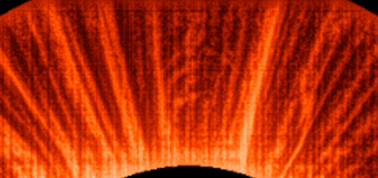4.04.2024
Solar Orbiter to watch for eruptions during total eclipse
On 8 April 2024, a great swath of the United States and Mexico will experience a total solar eclipse, with viewers getting the rare chance to see the Sun’s stunning outer atmosphere.
Solar Orbiter has a front-row seat
On the day of the eclipse, Solar Orbiter will be in a great location. Today, 4 April 2024, marks the spacecraft’s closest approach to the Sun in its egg-shaped orbit, coming just 44 million km from the Sun. These closest approaches happen roughly every six months. During the days before and after, all ten of the spacecraft’s scientific instruments are on high alert.
What’s more, Solar Orbiter will be observing the Sun side-on compared to our perspective on Earth. This means that the structures in the corona (the Sun’s outer atmosphere) that we see at the right-hand side of the Sun from Earth will be seen directly face-on by the spacecraft.

Position of Solar Orbiter on 8 April 2024, with Solar Orbiter’s turns around the Sun shown in green
Eruption watch campaign
Twice in every orbit Solar Orbiter makes around the Sun, so roughly four times a year, the spacecraft makes this 90-degree angle with Earth as it looks at the Sun. During these moments, the Solar Orbiter team may run an ‘eruption watch’ campaign, where they monitor the Sun for bursts of material sent in the direction of Earth.
The next eruption watch campaign will fall precisely around the total solar eclipse, running from 7–9 April. It is led by Clementina Sasso from the Italian National Institute for Astrophysics.
“It’s exciting to think that whilst people on Earth observe the Sun’s corona from one direction, Solar Orbiter will be observing it side-on, ready to capture any fiery outburst that might be heading towards our planet,” says Daniel Müller, ESA Solar Orbiter Project Scientist.
“With observations from the ground and from space, we will for sure be able to combine different points of view of the Sun’s corona,” adds Federico Landini from the Italian National Institute for Astrophysics, member of the Solar Orbiter Metis instrument team. “If there is an eruption event and it occurs in the direction of Earth, even better!”
During the October 2023 eruption watch campaign, Solar Orbiter witnessed at least three big eruptions. Fortunately for us on Earth (or unfortunately, if you were aurora-spotting at the time), none of them headed in our direction.
(Artificial) total eclipse of the Sun
It is a remarkable cosmic coincidence that the Sun is precisely 400 times wider than the Moon, and also 400 times further away. The result is that when the Moon passes in front of the Sun during a total solar eclipse, it precisely blocks out the entire face of the Sun – covering no more and no less.
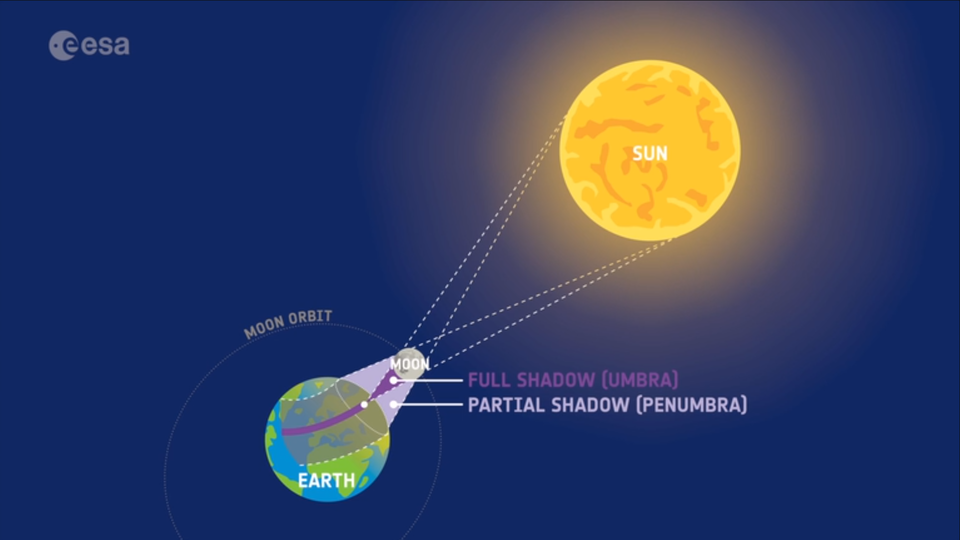
This lets us see the Sun’s wispy corona, which though super-hot, is also very faint, and is therefore usually drowned out by the Sun’s blindingly bright surface. The corona is fascinating for so many reasons, including because it is thought to be the origin of the solar wind.
To study the Sun’s corona, Solar Orbiter creates its own artificial eclipse. Its Metis instrument uses a mirror to reflect the light from the Sun’s surface back into space and only image the surrounding corona in visible and ultraviolet light. Metis is an example of a coronagraph, a specialised instrument designed to block out the light of the Sun.
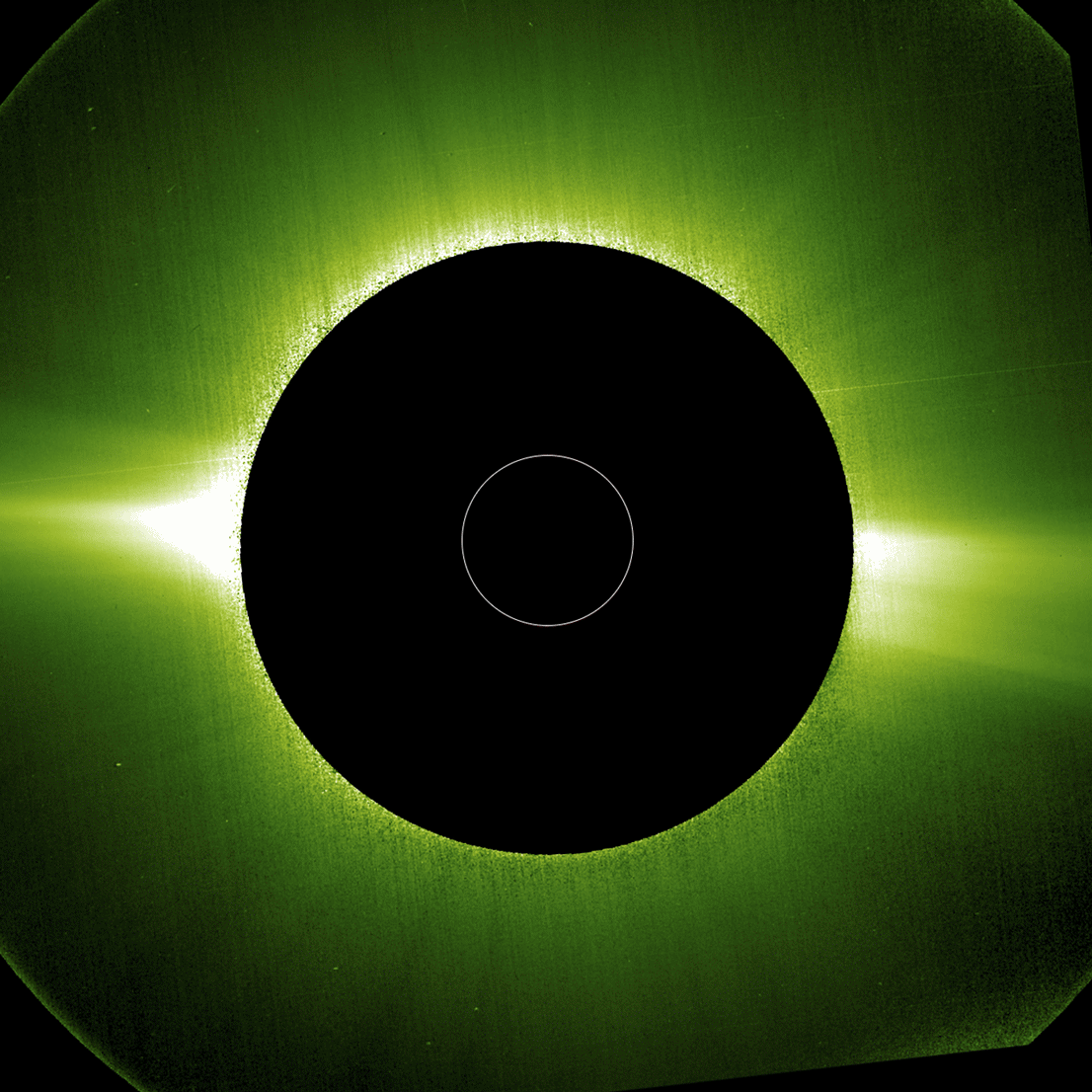
Proba-3 goes one step further
The bigger the distance between the light-blocking disc and the camera photographing the corona, the less light spilt around the coronagraph and the better our view.
ESA’s upcoming Proba-3 mission will be the ultimate coronagraph in space; two separate spacecraft will work together, one blocking the sunlight and the other observing the corona from 144 m away. This precision-flying experiment will let us observe closer to the solar rim than ever before.
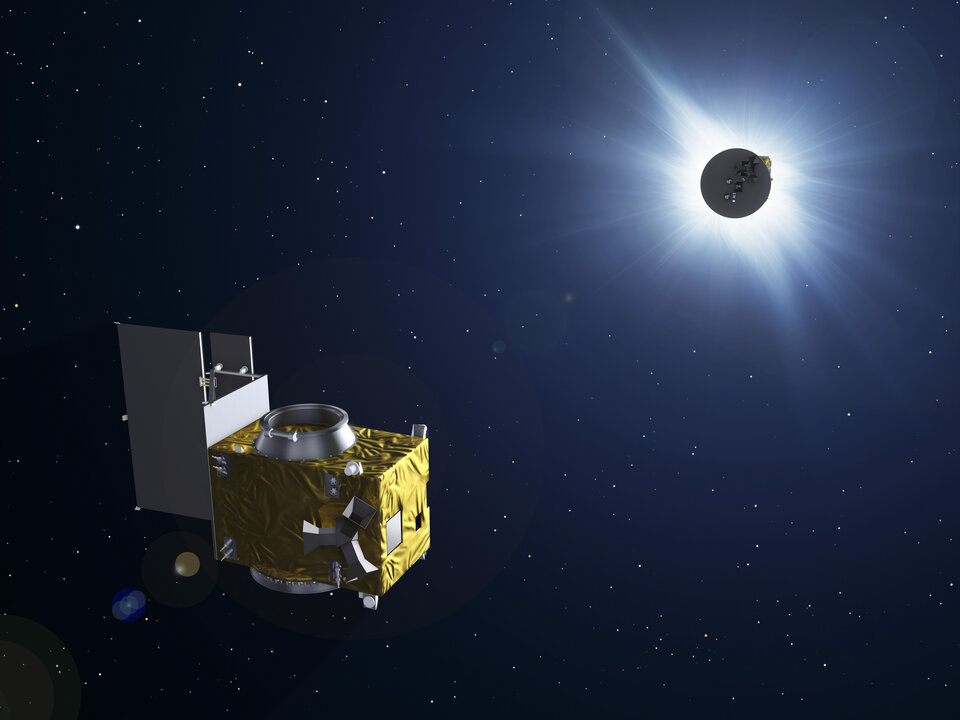
Proba-3’s main goal is to test new technologies and techniques. But if it works, we can expect exciting discoveries about the Sun, which would complement the views from Solar Orbiter.
Proba-3 is due to launch later in 2024. To test out some of the science instruments the spacecraft will carry, a team of Proba-3 scientists and engineers are heading to Mexico during the total solar eclipse. There, they will try out the instruments on the real solar eclipse to ensure that they work in tip top condition in space.
Quelle: ESA
----
Update: 22.06.2024
.
Proba-3: An ISRO-ESA venture to simulate Solar Eclipse
This autumn (September to November), the European Space Agency (ESA) will start an extraordinary mission: launching Proba-3, the world’s first machine to create an artificial eclipse

Before people understood that eclipses were natural astronomical events, many cultures had their own stories and explanations for them. Interestingly, many of these featured mythical creatures eating the Sun or the moon, causing people to consider eclipses as a bad omen.
This autumn (September to November), the European Space Agency (ESA) will start an extraordinary mission: launching Proba-3, the world’s first machine to create an artificial eclipse. This groundbreaking project uses two satellites working together to create a long-lasting, artificial solar eclipse in space—something that has never been attempted before.
Proba-3 tries formation flying on the ground

The two Proba-3 satellites were set facing each other across a cleanroom as cameras, LEDs, a laser and shadow sensors were activated in turn, testing the systems that will let the pair sense their precise positions relative to each other, allowing them to line up precisely in orbit down to a single millimetre.

When two satellites venture to within a few hundred metres of each other, the usual response is a collision avoidance manoeuvre. But ESA’s double-satellite Proba-3 will be performing a kind of controlled dance in orbit, its two elements coming as close as 25 m apart.
Lining up with the Sun
Around 150 m from each other, the pair will line up with the Sun to cast a shadow from one satellite to the other, creating prolonged artificial solar eclipses to reveal the faint outer atmosphere of the Sun without being blinded by its brightness.
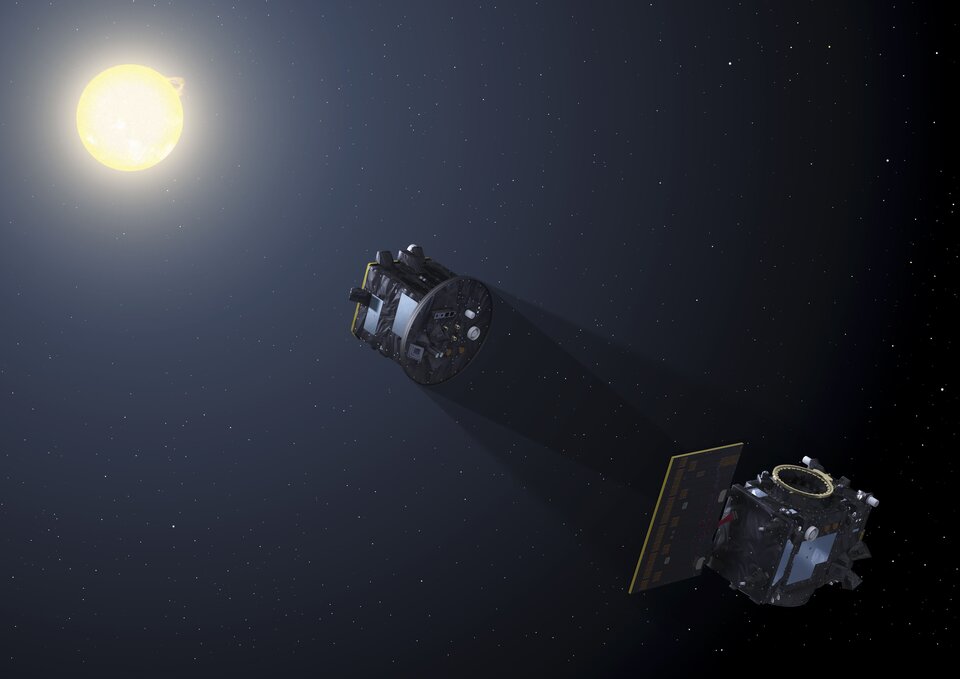
How will this be possible? Like autonomous cars on Earth, the Proba-3 satellites make use of multiple sensors using different technologies to derive their positions relative to each other.
All of these systems have to work perfectly for the mission to succeed – so they were tested together with the spacecraft software for the first time in the cleanroom of Redwire in Kruibeke near Antwerp in Belgium.


Access the video
“Proba-3 is a formation flying demonstration mission, and these systems really form the mission’s core,” explains ESA software and systems engineer Teodor Bozhanov.
“To maintain the position of the two satellites to the necessary precision we need to have performed specific steps in sequence, one after the other. Starting from optical observations we move to laser metrology then finally detection of the shadow being cast from one satellite to the other. If one of these steps is not a success then we cannot move on the next.”

Satellites face to face
The two Proba-3 platforms were placed a little over 15 m away from each other – the maximum distance available within the confined setting of the Redwire cleanroom – although in space the pair will be flying around ten times further apart when the mission’s formation flying systems come into use.
Personnel from Proba-3 prime contractor Sener in Spain joined the Redwire and ESA teams for the week-long test campaign, along with experts from Danish space research institute DTU Space, which manufactured Proba-3’s Vision Based Sensor system.

Radio, satnav and stellar navigating
The pair will be connected throughout their orbit using a radio-based inter-satellite link system from Tekever in Portugal, continuously updating their range from each other.
They will also chart their absolute positions in space using specially designed satellite navigation receivers, which need to take account of the fact that Proba-3’s highly elliptical 60 000 km altitude orbit will pass right through the orbits of satnav constellations and high up into space.
Finally the pair are additionally equipped with star trackers – computer-linked cameras that recognise the constellations around them to reveal each satellite’s ‘attitude’, or current pointing direction in space.

LEDs, cameras, laser – getting into position
It is once the satellites come closer than about 250 m from each other that the relative navigation systems used for precise formation flying come into play – trialled one after the other during this test campaign.
The first step is the Vision Based Sensor system. A wide-angle camera is used to track an LED pattern on the other satellite, providing relatively coarse information on the satellites’ distance from each other, as well as supplementary information on their attitude.
This is supplemented by a narrow-angle camera which locks onto a second, much smaller LED pattern, providing relative positioning information down to a scale of about a single centimetre.

Millimetre accuracy achieved
Next in sequence, the Fine Lateral and Longitudinal Sensor on Proba-3’s ‘Occulter’ spacecraft shines a laser towards a corner cube retro-reflector on the face of the ‘Coronagraph’ spacecraft, which is reflected back in turn to the Occulter. This FLLS provides relative positioning down to millimetre accuracy.
The final positioning technology is the Shadow Positioning Sensor system, based on photo detectors arranged around the lens that Proba-3’s main coronagraph instrument will use to monitor the Sun’s surrounding corona.

If the approximately 5-cm diameter shadow is cast correctly, centred onto the Coronagraph, then it should be equal in illumination on all sides; any discrepancy would trigger a correction.
First time combined testing
“All these systems have been tested before at unit level and in simulations,” comments ESA guidance, navigation and control engineer Jonathan Grzymisch. “But this was really the first time that all our hardware and software was operated together, as it will operate in space. The navigation system was processing actual hardware inputs, in sequence from coarser measurements to finer and finer metrology.

“The constrained size we were working with led to a complex test setup, because basically we are tricking the guidance, navigation and control software to work outside of its operational domain. For instance we used a robot from our Guidance, Navigation and Control Lab at ESTEC in the Netherlands to hold a laser retroreflector, because the test layout didn’t permit alignment with the real one on the Coronagraph satellite.
“In the event however, the testing went quite smoothly, bringing us a step nearer to launch readiness. The next time all these systems run together will be in space, after the mission begins.”
Proba-3 is scheduled to launch this autumn on an Indian PSLV-XL launcher.
Quelle: ESA
----
Update: 9.07.2024
.
Parker Solar Probe Achieves 20th Close Encounter with the Sun

NASA's Parker Solar Probe successfully made its 20th close approach to the Sun on June 30, 2024. The probe came within 4.51 million miles (7.26 million kilometers) of the Sun's surface, equaling its previous distance record.
"The close approach (known as perihelion) occurred at 3:47 UTC (11:47 p.m. EDT on June 29), with Parker Solar Probe moving 394,736 miles per hour (635,266 kilometers per hour) around the Sun, again matching its own record." On July 2, mission operators at the Johns Hopkins Applied Physics Laboratory in Laurel, Maryland, confirmed the spacecraft was in good health after receiving a beacon tone indicating normal system operations.
"The spacecraft checked in with mission operators at the Johns Hopkins Applied Physics Laboratory in Laurel, Maryland (where the spacecraft was also designed and built), with a beacon tone indicating it was in good health and all systems were operating normally."
This milestone represents the midpoint of the mission's 20th solar encounter, which began on June 25 and will continue until July 5.
Parker Solar Probe is scheduled to repeat this close approach on September 30, 2024. The mission will then proceed to make three final planned close approaches, beginning on December 24, 2024. During this approach, aided by the last Venus gravity assist on November 6, the spacecraft will reach a distance of just 3.8 million miles from the Sun, traveling at about 430,000 miles per hour.
Quelle: SD
----
Update: 30.09.2024
.
European twin satellite mission bids to create total solar eclipse on demand
One craft will block the view of the sun from the other to deepen understanding of solar disruptions on terrestrial technology

European scientists are preparing to launch a space mission that has been designed to create total eclipses of the sun on demand.
The robot spacecraft Proba-3 will be launched by the European Space Agency(ESA) in a few weeks in a mission which will involve flying a pair of satellites in close formation round the Earth. They will be linked by lasers and light sensors, with one probe blocking the view of the sun as seen from the other craft. The effect will be to create solar eclipses that will last for several hours.
Observing these eclipses will revolutionise the study of the sun and understanding of how it can cause disruptions to power lines, GPS satellites and other earthly technologies, says ESA. The agency believes the mission will also act as a pathfinder for other formation spaceflights that could transform studies of gravitational waves, exoplanets and black holes.
“This is an extraordinarily promising technology,” said solar physicist Francisco Diego of University College London. “It is also highly technically challenging. Getting it right will not be easy, but it will be highly rewarding.”
The mission, which has taken more than 10 years to plan, has involved developing a series of complex sensors that will keep the two satellites locked close together with an accuracy of less than a millimetre as they fly round the Earth 144 metres apart. In effect, the two probes will act as a single 144m-long observatory.
“When the two satellites are in exactly the right orbit, one will release a disk that will exactly the cover the sun as seen from the second satellite and so create eclipses that will last for up to six hours a day,” Proba-3’s project manager, Damien Galano, told the Observer.
On Earth, total solar eclipses occur when the moon passes in front of the sun, blocking out its blinding glare and leaving its fiery atmosphere – the corona – open to study by astronomers.
“Unfortunately, total solar eclipses happen on average every two years or so on Earth, and scientists often have to travel long distances and be at the mercy of the weather to study them – while observations can take place for only a few minutes,” added Diego. “That does not provide much time to make detailed observations.” Similarly, devices – called coronagraphs – that mimic eclipses and which are fitted to telescopes cannot observe the sun’s inner corona in detail.”
Scientists are particularly keen to study the sun’s inner corona because of its temperature. The sun’s surface is around 6,000C, while the temperature of its corona is about 1 million degrees. “That is a paradox,” said Andrei Zhukov, principal investigator for the corona experiment that will be flown on Proba-3. “You would expect it to get colder as it went further from the sun, but that is not the case.”
By allowing scientists to create solar eclipses that last for hours, Proba-3 should generate the data that will solve this mystery. “We will be able to study the inner corona at length and in detail, and generate information that will explain why it is so hot while the sun’s surface below it is relatively cool. That should give us a handle on understanding how the sun influences space weather,” added Diego.
This point was backed by Zhukov: “The sun is the source of disturbances to space weather, which can affect GPS navigation, power transmission and other technology. We need to understand how it does that.”
“In general, we are protected by the atmosphere and the Van Allen radiation belts that surround the Earth,” said Diego. “However, in deep space there is no such protection from this radiation, and if we want to send men and women to the moon and Mars, we want to be able to understand and predict how the sun’s corona is going to behave and so prevent our astronauts from being harmed.”
Proba-3 should do more than revolutionise solar physics, however. As a pathfinder for the technology of flying probes in formation, it could form the core of a whole new approach to robot spaceflight – by using a few small satellites to mimic the operations of a single giant spacecraft, say astronomers.
“The techniques developed to operate Proba-3 could be exploited for many other astronomical missions, including groups of satellites that could study black holes, exoplanets, gravity waves and many other phenomena,” added Galano. “This whole approach to spaceflight has a great deal of promise.”
Quelle: The Guardian

